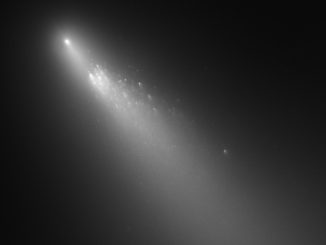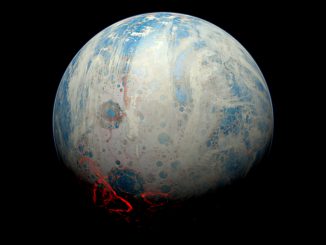
Methane




Intense storms batter Saturn’s largest moon, scientists report
Titan, the largest of Saturn’s more than 60 moons, has surprisingly intense rainstorms, according to research by a team of UCLA planetary scientists and geologists. Although the storms are relatively rare — they occur less than once per Titan year, which is 29 and a half Earth years — they occur much more frequently than the scientists expected.

Relationship revealed between chemicals found on comets
A new study reveals similarities and relationships between certain types of chemicals found on 30 different comets, which vary widely in their overall composition compared to one another. The research is part of ongoing investigations into these primordial bodies, which contain material largely unchanged from the solar system’s birth some 4.6 billion years ago.


Pluto ‘paints’ its largest moon red
In June 2015, when the cameras on NASA’s approaching New Horizons spacecraft first spotted the large reddish polar region on Pluto’s largest moon, Charon, mission scientists knew two things: they’d never seen anything like it elsewhere in our Solar System, and they couldn’t wait to get the story behind it.

Primordial asteroid impacts a possible solution to “faint young Sun paradox”
In the first billion years of Earth’s history, the planet was bombarded by primordial asteroids, while a faint Sun provided much less heat. A Southwest Research Institute-led team posits that this tumultuous beginning may have ultimately fostered life on Earth, particularly in terms of sustaining liquid water.

Detection of methanol shows comets are forming in distant solar system
Astronomers have found the organic molecule methyl alcohol, or methanol, in the protoplanetary disc of TW Hydrae, 175 light-years from Earth — the first such detection of this chemical compound in a young planet-forming disc. Since methanol forms on the icy coatings of dust grains, this discovery provides a window into the region where comets are likely forming.

Astronomers discover nearby Jupiter-like exoplanet enshrouded in methane
The Gemini Planet Imager instrument has discovered and photographed its first planet. Dubbed 51 Eridani b, the body is a methane-enshrouded gas giant that is the most Jupiter-like exoplanet ever directly imaged, in a planetary system just 20 million years old. It may hold the key to understanding how large planets form in the swirling accretion discs around stars.
